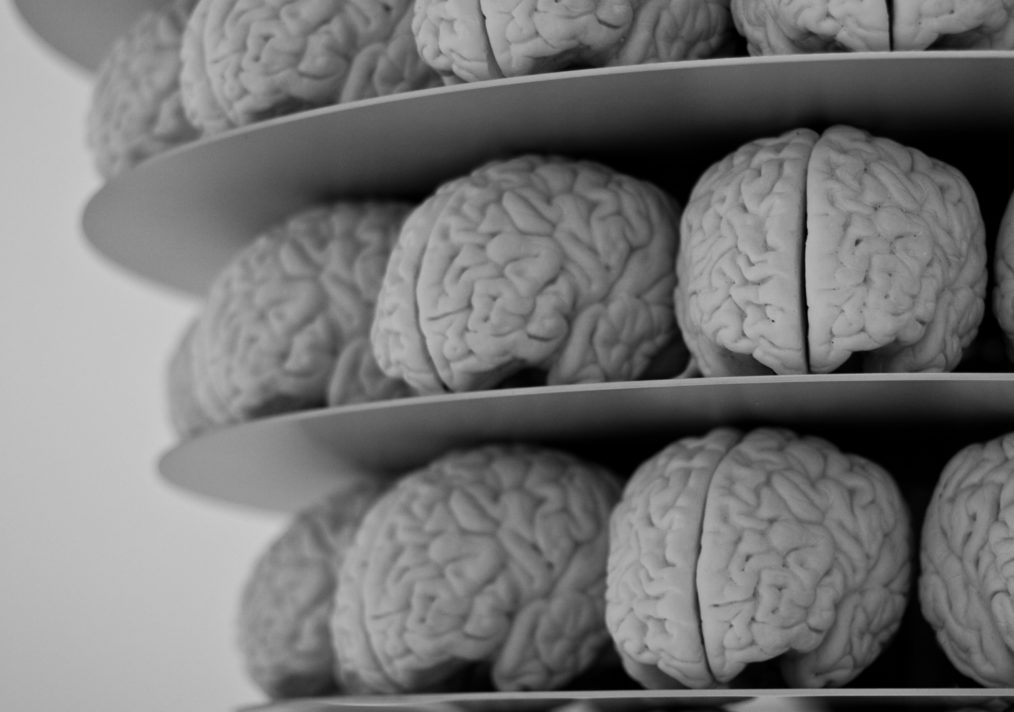
Is the left brain not able to monitor linguistic errors during effortful tasks in ADHD?
Error-monitoring, in broader term, is defined as the ability to observe and evaluate whether our behaviors are appropriate for the surrounded context. For example, when start writing a blog post or a newspaper article, one may use abbreviations of some scientific terms and later realize that the terms have not been introduced before and they do not fit with the content, or that the written language is very abstract, specific, and complicated for the general public audience. Error-monitoring is about being aware of our errors and how we can adjust our behaviors to correct these errors. We essentially need this ability for learning, flexible adaptation, and achieving our future goals.
Clinical research has given evidence for a compromised error-monitoring in individuals diagnosed with Attention-deficit/Hyperactivity Disorder (ADHD). This evidence is based on two main experimental findings: First, the absence of so-called “post-error slowing” in subjects with ADHD. Post-error slowing is a phenomenon, showing that healthy individuals recognize their errors and consequently they slow down their responses after errors to prevent making new ones on subsequent trials. Second, compared to healthy individuals, individuals with ADHD manifest abnormal brain activity when errors occur. EEG studies have suggested that both early detection of errors and performance evaluation are affected in ADHD (for a review see Shiels & Hawk, 2010).
“Why do subjects with ADHD have poor error monitoring?”
So far, the cause of poor error-monitoring in ADHD is still unclear. Some researchers have attributed poor error-monitoring to problems in allocating sufficient effort to complete the task in a proper way. That is to say, individuals with ADHD have intact error-monitoring when the task is not effortful (like simple and short tasks), but as soon as the task is getting more effortful (being long, boring, and repetitive) the performance drops. For example, when you start categorizing or revising your library collection based on type of field, the task will be easy if you have a collection that consists of 50 books (condition A) than if you have a collection that consists of hundreds of books (condition B). You may expect few errors in condition A with an ease to detect and correct them, whiles in condition B you may expect more errors, which require more effort to detect and correct them. This means that if a person has a problem in allocating sufficient effort in condition B (like an ADHD subject), he/she will not notice errors, and even if he/she notices errors he/she will not put enough effort to correct them.
One experimental way to manipulate effort allocation is by changing the speed at which visual stimuli are presented from fast to slow rate. Previous studies showed a decline in task performance when the presentation rate is becoming slower, as it requires more effort to keep the participants motivated. In a meta-analysis by Balogh and Czobor (2014) it was found that less post-error slowing is associated with slower stimulus presentation rates in individuals with ADHD. One might argue that subjects with ADHD may be consciously aware of their errors, but they cannot adjust their responses accordingly due to weak effort allocation.
Whether the two halves of our brain (left and right cerebral hemispheres) have different contributions to post-error response adjustments is not clear, albeit most of the neuro-imaging data support the notion that the left hemisphere is the most promising candidate to sub-serve error-processing (Hochman et al., 2011). Zaidel and colleagues (Zaidel, Clarke, & Suyenobu, 1990; Kaplan and Zaidel, 2001) have proposed that each hemisphere has its own abilities and resources to monitor errors. I quote “It is possible that each hemisphere has its own independent executive control, including the ability to monitor errors and adjust performance accordingly. Another possibility is that one hemisphere may be specialized for the monitoring of errors” (Kaplan & Zaidel, 2001).
“Within this spirit, we conducted a study to investigate the contribution of each hemisphere to error-monitoring (measured by post-error response adjustments) in university students with low and high level of ADHD symptoms.”
Individuals performed a divided visual field linguistic task with two conditions: fast and slower stimulus presentation rate. In the task, visual objects/stimuli are presented to one side (right or left) of a central fixation point. Anatomically, visual neural pathways (from the eyes to brain areas which are responsible for processing visual objects) are lateralized. Visual objects presented to the right side of a central fixation point are initially processed by the left hemisphere and conversely, visual objects that appear on the left side of the central fixation are initially processed by the right hemisphere. The basic task procedure involves measuring how quickly and accurately people recognize letter strings, presented to each visual field/ hemisphere, as words or nonwords. Individuals also filled in a number of self-report questionnaires measuring ADHD symptoms, daily life functioning, and executive functions in daily life context.
“In the study we adopted an approach that considers ADHD as a dimensional quantitative trait rather than a categorical disorder.”
Many reports showed that normal subjects vary in their ADHD symptoms which are more or less normally distributed. The dimensional approach considers individuals who are at risk to be diagnosed with ADHD. Studying such a sample can tell us a lot about possible factors that trigger ADHD and its etiological mechanisms. The approach also considers impaired individuals who are not formally diagnosed because they do not meet all diagnostic criteria of the DSM or the ICD such as adults who were not identified with the disorder in their childhood as a result of disagreements between clinicians or conflict between different information resources (such as parents and teacher rating scales).
The study outcomes showed that post-error response adjustments were absent in the group with higher ADHD scores. The severity of ADHD symptoms were specifically associated with both insufficient effort allocation and decreased left hemisphere capacity to manipulate errors. In contrast to adults with lower level of ADHD symptoms, adults with higher ADHD levels showed neither post-error slowing nor enhancement in post-error accuracy when stimuli are presented to the right side of a central fixation point (stimuli are initially processed by the left hemisphere) during the slower stimulus presentation rate.
“To interpret these outcomes, we first need to get a close-up view about how each hemisphere manipulates errors.”
Each half of the brain has a monitoring system that makes a comparison between completely processed information and the executed response. If the system recognizes an erroneous response for a given information, it gives a signal to the specialized areas in each half of the brain, alarming that more time is needed to complete the processing of incoming (input) information and to prepare for the appropriate (output) response. As a result, responses after errors are slower and more accurate. If an error resulted from incomplete processing of a stimulus rather than responding, then the monitoring system cannot specify the appropriate response and cannot recognize whether the response is an error or not. The weak ability of the left hemisphere to process linguistic information in subjects with ADHD may explain why they could not detect errors at first place. Simply, if the left hemisphere sees no error, no post-error response adjustment will be made.
A second explanation of the study outcomes is that the left hemisphere is able detect errors, but cannot adjust the responses, accordingly. The explanation comes from a number of studies, indicating that the two halves of our brain are specialized in two different types of efforts: the right hemisphere is more responsible for allocating cognitive effort, which is needed to process difficult and complex input information; while the left hemisphere is more specialized in allocating effort that is needed to prepare and execute output motor responses. This explanation might be more acceptable since the decreased left hemisphere ability to monitor errors is only observed in the task condition that requires more effort (the slower stimulus presentation rate) and that the cognitive load of the task (stimuli features and instructions) was the same in the fast and in the slower stimulus presentation rate.
These outcomes are consistent with the majority of clinical studies showing that ADHD is associated with poor error-monitoring (Balogh & Czobor, 2014).
“The findings are in agreement with previous studies and reviews proposing that (1) poor effort allocation appears relevant to ADHD, and (2) the left hemisphere is more involved in error-processing, motivation, motor and language dysfunctions in ADHD.”
Concerning the ecological validity of the reported findings, results showed significant relations between the reported experimental effects and daily life dysfunctions in domains of family, work, learning and school/college, life skills, social functioning, risk-taking, and daily tasks that require motivational drive, organization, impulse control, and strategic planning. This indicates that our findings are ecologically relevant. So what does it mean? It generally means that subjects with high level of ADHD symptoms may show functional impairments in daily life activities, likely, because they do not put enough effort on long, boring, repetitive, and/or frustrating difficult daily tasks.
“Using a metaphor, subjects with high level of ADHD symptoms have a good engine, but they lack a petrol supply. Seeking for something that keeps individuals stimulated and motivated like rewards will help to have an optimal functioning.”
Responding or processing linguistic information is, specifically, essential to accomplish a lot of daily tasks, because many of them use either written or spoken language. Subjects with high level of ADHD symptoms may have poor performance as a result of not putting effort to carefully read instructions, listen, or correct their errors and this could be due to by deviant processing in the left brain.
In conclusion, findings underline the role of effort allocation and atypical left hemisphere functioning as contributing factors to poor error-monitoring in ADHD.
Our articles:
Mohamed, S. M., Börger, N. A., Geuze, R. H., & van der Meere, J. J. (2016). Post-error adjustments and ADHD symptoms in adults: The effect of laterality and state regulation. Brain and Cognition, 108, 11-19.
Mohamed, S., Geuze, R. H., Borger, N., & van der Meere, J. J. (2017). Toestandregulatie, hersenlateralisatie en ADHD-symptomatologie bij volwassenen. Neuropraxis, 21(3), 49-57.
Other relevant articles:
Balogh, L., & Czobor, P. (2014). Post-error slowing in patients with ADHD: a meta-analysis. Journal of Attention Disorders, 20(12), 1004-1016.
Hochman, E. Y., Eviatar, Z., Breznitz, Z., Shaul, S., & Nevat, M. (2009). Different laterality patterns of the error-related negativity in corrected and uncorrected errors. Laterality, 14(6), 618-634.
Kaplan, J. T., & Zaidel, E. (2001). Error monitoring in the hemispheres: the effect of lateralized feedback on lexical decision. Cognition, 82(2), 157-178.
Shiels, K., & Hawk, L. W. (2010). Self-regulation in ADHD: the role of error processing. Clinical Psychology Review, 30(8), 951-961.
Zaidel, E., Clarke, J. M., & Suyenobu, B. (1990). Hemispheric independence: a paradigm case for cognitive neuroscience. Neurobiology of Higher Cognitive Function, 297-355.
NOTE: Image by Neil Conway, licensed under CC BY 2.0



